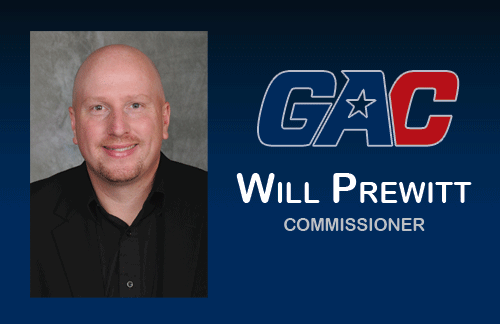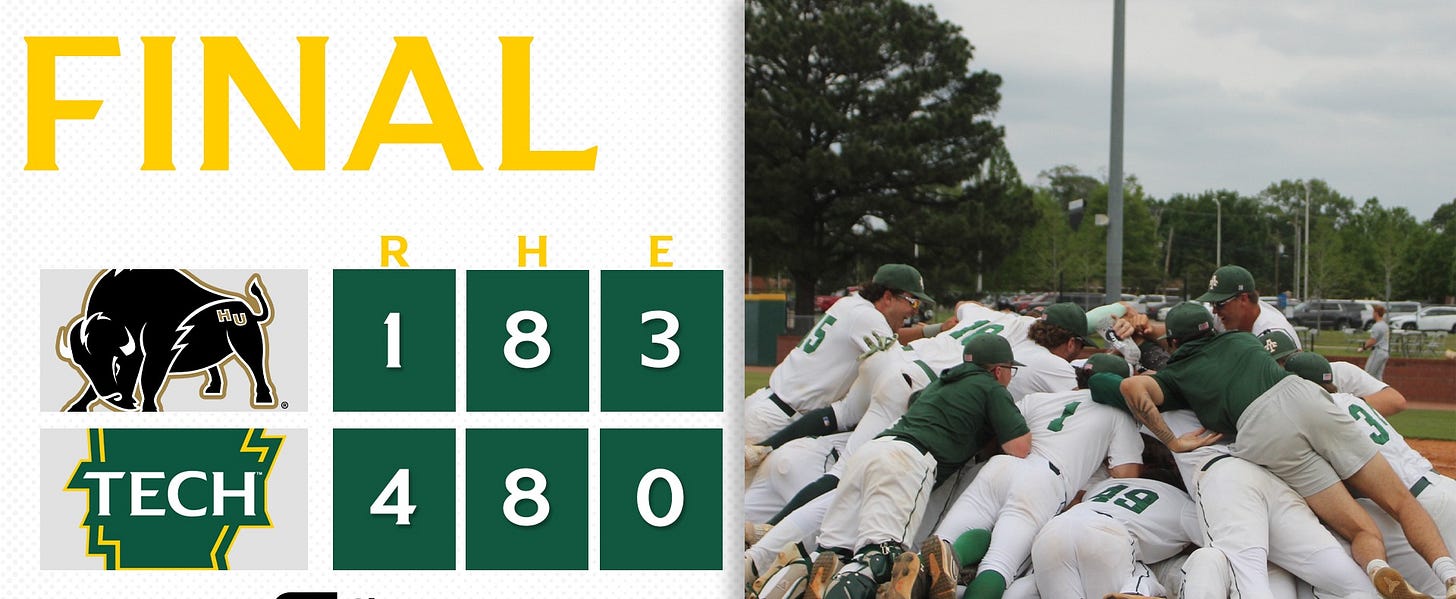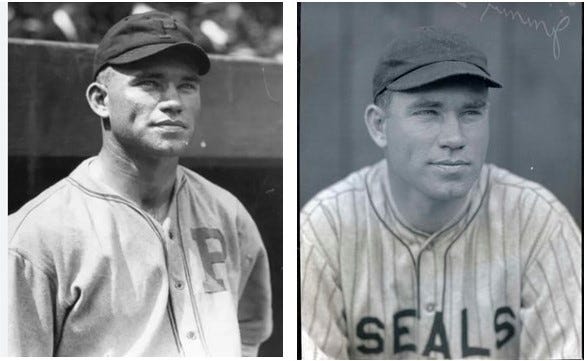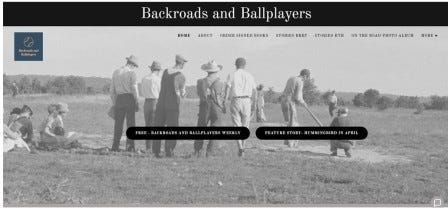Backroads and Ballplayers # 107
Stories of the famous and not-so-famous men and women from a time when baseball was "Arkansas' Game." Backroads and Ballplayers Weekly is always free and short enough to finish in one cup of coffee.
Thoughts on Division II, “Workup,” and Best of the Lost Stories Guys Part I, Jimmy Zinn
Division II…For the Love of the Game
This week begins college baseball’s three weeks at the top of the sports page. The crowded and sometimes hectic college sports calendar changes to a leisurely stroll toward a culminating championship in Omaha, Nebraska.
For most of the participants, it is the high point of their baseball life. They may not know that until they reflect on it from their recliner. A few will play successfully at the professional level, but playing for pay will never equal the fun of playing with your buds.
As I have mentioned many times in this space, I am a big fan of the Division II league that plays in my town. The Great American Conference is a twelve-team conference that is a descendant of two historic old leagues: the Arkansas Intercollegiate Conference and the Oklahoma Intercollegiate Conference.
I became acquainted with the GAC Commissioner, Will Prewitt, at an SABR meeting about 8 years ago. His office is about a mile from my home. He is much easier to drop in on with a story than Greg Sankey.
A commissioner in a twelve-team Division II conference keeps dozens of balls in the air from August until late May. The GAC obviously knows his value. Will Prewitt is the only commissioner the GAC has ever had.
Baseball is played at a high level in the GAC by guys who weren’t bought with NIL money, travel hours by bus to road games, and, as the NCAA proudly boasts in their promo, “most will leave college for careers other than sports.”
Below is a story of one of these outstanding young men. His college baseball bio is similar to hundreds of other men and women playing for a love of the game, in college leagues below Division I.
Luke Ray
Luke Ray was a student at Arkansas Tech. He is a local guy. I remember seeing him in church with his family when he was a toddler. Ray is a Dean’s List student majoring in engineering. He has a career GPA near 4.0 in one of the school’s most demanding programs. Luke Ray made the most of his time at Arkansas Tech University, and that work will undoubtedly pay off, but not in the MLB Draft.
By the way, he was a standout defensive second baseman and clutch hitter for the Great American Conference Champion, Arkansas Tech Wonder Boys. It took four seasons for him to live that dream, but he continued to work and dream his dream. He eventually earned that dogpile with his teammates in the last home game of the season. Perhaps no one enjoyed the season more than Luke Ray.
After playing sparingly his first three years at Tech, Ray emerged as a standout in his final season. Always a steady defensive player, in 51 starts as a senior, he batted .288, hit a grand slam home run in a conference game in mid-season, and went three for four in the final regular season game that clinched the title.
You won’t find Ray’s name on the All-GAC Baseball Team. You will find it on the conference Academic Honor Roll. Luke Ray is not expecting a phone call from a major league team on draft day. He will probably be working on his resume. He will always cherish the memories of his college baseball career.
Unquestionably, there are hundreds of stories in Division II about men and women like Luke Ray, who played for the love of the game.
I managed to catch most of Arkansas Tech’s home games. They were well-coached, fundamentally sound, and they came back from a slow start to win the league title on the last day of the regular season. All the Arkansas GAC members were still in the pennant race on the last weekend.
Find a Division II, Division III, or Women’s softball team near your home next spring. You will become an instant fan.
Playground Baseball Revisited
I received several emails this week about “choosing up.” Most of those were private, and I promise to keep them that way. Mrs. Ohtani would not like to see them, but I suspect she is not a subscriber.
I will reveal the not-so-surprising fact that no reader who responded would select Shohei Ohtani if they had the first choice in a playground draft of major league baseball players. Some of you predicted that he will never pitch regularly again, although Dave Roberts seems to be hinting that he will make a mound appearance soon.
I think he is a generational player, but has he already earned a first-ballot Hall of Fame selection? I am just not sure. Some of you must agree. You revealed that a Dodger would be your first choice in the “playground team draft,” but Ohtani was not the selection.
Below is your last chance to comment about who you would choose as your first selection for a playground team composed of current major leaguers. The comments below are public, but you can email me privately at the email address below:
backroadsballplayer@gmail.com.
___________________
A Subscription sends these weekly posts to your mailbox. There is no charge for the subscription or the Backroads and Ballplayers Weekly.
If you do not wish to subscribe, you will find the weekly posts on Monday evenings at Backroads and Ballplayers on Facebook. SAVE THE LINK…
____________________
Questions and Answers?
Rules to “Workup”
Another topic that popped up in a discussion of playground baseball was a game called “workup.” Someone was impertinent enough to ask about the rules of this undocumented individual game. The “official rules” to “workup” or “work up,” probably do not exist.
In the White Oak Grade School version of the game, batters competed individually, but I don’t remember scores being recorded. Batters continued to be “at bat” until they made an out. At that point, the batter went to right field or some area of the outfield to “work” his way back to bat. After each out, the players in the field would advance one position until they once again became a batter. How many players were needed? I recall that somewhere between three and 25 or so was acceptable.
There were several “ghost runner” situations required if the number of players was too low for adequate defense. Those adaptations were implemented at the discretion of the player who seemed to know more about the “rules” than other, less confident participants.
I fear this generation of youngsters would not grasp the complexities of workup.
YOUR TURN
Most Tragic Lost Story
A reader asked me who I thought was the most overlooked Arkansas-born player in Arkansas baseball history. That is my kind of question. I am going to dodge the specific question and name four.
Without reviewing my notes, four of my all-time favorite Arkansas guys come to mind. Smead Jolley, Earl Smith, Aaron Ward, and Jimmy Zinn are among the best players our state has ever produced, yet their stories have been overlooked.
An unfortunate common denominator is that none of the four are in the Arkansas Sports Hall of Fame and are very unlikely ever to be selected. In the playground game in my mind, these guys would be among the first players chosen. Over the next few weeks, I will review one season in each of their careers.
Jimmy Zinn 1930
The Iron Man of Arkansas Baseball
Jimmy Zinn was 35 years old in 1930. He had spent the previous season with the Cleveland Indians in the American League and had one of the worst years of a pro career that would eventually span 25 years and more than 300 professional pitching victories.
In the winter off-season, the Indians sold Zinn down to the San Francisco Seals in the Pacific Coast League. The 1930 version of the PCL played a 200-game schedule extending from the first week in April until mid-October. The Seals won 100 games, but that plateau of big-league excellence earned only a fourth-place finish in the PCL.
San Francisco had plenty of work for a unique talent like Jimmy Zinn. The 15-year veteran could pitch every fourth day, relieve between starts, and fill in as a position player on days he did not pitch. Zinn’s unique workload hardly earned a headline, 90 years before Shohei Ohtani.
A month into the 1930 season, Zinn pitched a no-hitter against the Sacramento Senators in Sacramento. By midseason, he was the ace of the staff and a regular outfielder and pinch hitter. Although he would not reach the big leagues again, Jimmy Zinn was having a career year.
James Edward Zinn was born in 1895 in Benton, Arkansas. By age 15, he was playing on the men’s teams of the Little Rock City League, first as a catcher for Benton, and later as a pitcher for Argenta, where the family resided while he was in high school.
At age 20, Zinn was signed to his first pro contract by the Class B Waco Navigators of the Texas League. Waco farmed him out to the Fort Smith Twins of the Western Association for the 1915 season, where he immediately became the ace of the Twins’ staff. His pitching record shows 190 innings pitched in 20 games, an average of 9.5 innings per outing.
Although the innings-pitched total seems to be an error, it is likely accurate. It was a time in baseball history when complete games were expected. In one extreme example, on May 27, 1915, Zinn pitched all 19 innings of a 1–1 tie. By 1930, playing on days he did not pitch was commonplace for Jimmy Zinn.
In 1930, Jimmy Zinn led the PCL in pitching victories with 26, and he hit .326 in 193 at-bats. Unlike the pitchers who had good hitting seasons a time or two in their career, winning 20 games and batting .300 were his expectations in the 23 seasons Zinn played professional baseball. He won 20 games or more five times, 18 in three other seasons, and he batted better than .300 ten times.
Does Jimmy Zinn hold a distinction unmatched in professional baseball? Researchers at the Robinson-Kell Chapter of SABR conclude that Zinn is the only pitcher in baseball history to have 300 professional pitching victories and a lifetime batting average above .300. In games at all levels, he is credited with 308 professional pitching victories. He posted a cumulative batting average of .301 over all his major league and minor league appearances.
After his last season in pro baseball, Zinn continued to play for semipro teams in California. He served as player-manager of the El Paso Texans of the Class D Arizona-Texas League in 1937 and 1938. Zinn later managed teams in Jacksonville (Texas), Sioux City (Iowa), Albuquerque, Fort Lauderdale, and Gadsden (Alabama) between 1939 and 1948.
During World War II, he worked at the Maumelle Ordnance Works in Arkansas. Zinn spent several summers as an instructor at Dr. Earl Williams’ Greenbrier Baseball School
Zinn worked for the Arkansas State Highway Department from 1949 until his retirement in 1962. He and his wife also worked with disabled children at the Conway (Arkansas) Children’s Colony. (Arkansas Human Development Center)
Jimmy Zinn died in Memphis on February 26, 1991, at age 96. He is buried in Oakland Cemetery in Little Rock.
____________________
More Arkansas baseball history and book ordering information: Link
Welcome, new subscribers. Have you missed some posts? Link












Well, somebody else said this last week, and I'm totally a homer here, but I'd have to take Bobby Witt Jr. for my playground team, even with his recent slump.